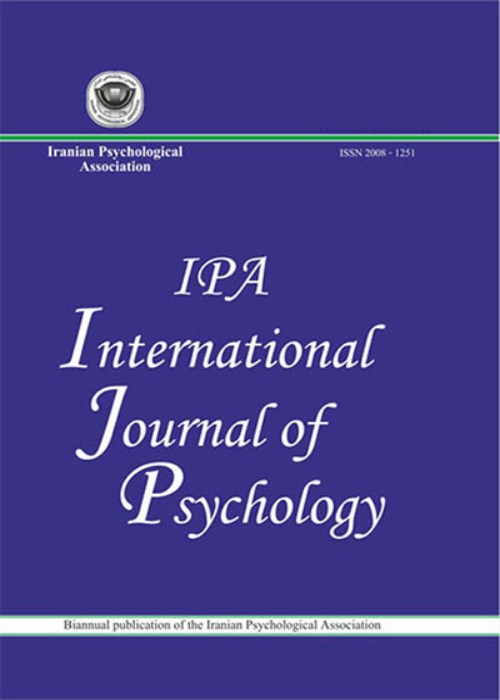فهرست مطالب
International Journal of Psychology
Volume:1 Issue: 2, Winter 2007
- تاریخ انتشار: 1386/10/01
- تعداد عناوین: 6
-
-
Page 1The purpose of the present study was to investigate the relationships of goal orientations, role conflict and ambiguity to competitive anxiety of athletes. The sample consisted of 224 male volleyball players of Iran Universities. The athletes representing 20 different teams participated in the study. Three instruments were used: Goal Orientations in Sport Questionnaire, Role Conflict and Ambiguity Scales, and Competitive State Anxiety Inventory-2. Role ambiguity, role conflict, and ego orientation had positive and significant correlations with competitive anxiety of athletes, 0.25, 0.26, and 0.24, respectively; while the correlation of task orientation with competitive anxiety was significant and negative, -0.23. The multiple regression analyses showed that role conflict, role ambiguity, ego orientation and task orientation were the best predictors for competitive anxiety.Keywords: goal orientations, role conflict, role ambiguity, competitive anxiety
-
Page 18The aim of this study was to study the relationships between coping strategies and the severity of PTSD. Subjects were 50 treatment seeking Iranian veterans who had experienced war trauma at least once during their military services. Two instruments were used, including: Ways of Coping Questionnaire (Lazarus and Folkman, 1985) and Structured Interview for PTSD (SIP). Correlation coefficients were computed between various coping strategies and the PTSD severity scores. Results indicated that seeking social support, positive reappraisal, planful-problem solving, and self-controlling strategies were negatively correlated to PTSD severity. Escape-avoidance, distancing, accepting responsibility and confronting coping were positively correlated to the severity of PTSD. Theoretical discussion and the applications of these results are represented.Keywords: coping strategies, PTSD severity, Iranian veterans
-
Page 35The aim of the present study was to examine the relationships of fear of negative evaluation and fear of negative appearance evaluation to body image concern among women seeking plastic surgery. The sample consisted of 180 female patients. The subjects completed 3 scales: Fear of Negative Evaluation scale (FNE), Fear of Negative Appearance Evaluation scale (FNAE) and The Body Image Concern Inventory (BICI). Data were analyzed using correlation and multiple regression analyses. Results showed that the relationships of Fear of negative evaluation and fear of negative appearance evaluation to body image concern were statistically significant. In addition, fear of negative appearance evaluation was the best predictor of body image concern among women seeking plastic surgery. The present findings highlight some recommendations for these patients that lead to positive evaluation about real body image.Keywords: fear of negative evaluation, fear of negative appearance evaluation, body image concern, plastic surgery
-
Page 47The different scales for assessing schizotypal traits were developed from different perspectives. These scales confined themselves only to certain aspects (syndromes) of the schizotypal personality, and they do not represent the nine features of schizotypal personality outlined in DSM-IV-TR. In contrast the Schizotypal Personality Questionnaire and its brief version are symptom-oriented and more comprehensive scales based on clinical features of schizotypal personality disorder described by the DSM. The aim of this study was to investigate the psychometric properties of the Schizotypal Personality Questionnaire-Brief (SPQ-B). The current study was conducted in survey and cross sectional as well as ex-post facto research context. In order to study the reliability and validity of the SPQ-B, its items were translated into Persian and then retranslated into English. A group of 402 normal participants (160 males 242 females) from colleges of Allameh Tabatabaie University took part in this research. Principal Component Analysis with promax rotation for SPQ-B extracted three factors which were labeled cognitive perceptual deficits, interpersonal deficits, and disorganization factors, respectively, and accounted for 32.64% of the variance. However, for this scale two other types of validity (convergent validity intercorrelations between subscales and the whole scale) and two reliabilities (test retest internal consistency) were reported. Based on these results, it was concluded that SPQ-B possesses good validity and reliability in Iranian population and it can be used, as a valid measure, in psychological and psychiatric research. The results of this study also support prior findings of gender differences in schizotype scores.Keywords: Schizotypal Personality Questionnaire, schizotypal personality disorder, validity, reliability, psychometric properties
-
Page 62The present study examines Bandura’s agentic model of depression as well as modeling emotional domain of self efficacy in adolescence depression. The selected sample was 946 high school students (471 females and 475 males) from north, south, east, west and central Tehran. The schools were chosen randomly. Participants completed Child Depression Inventory (CDI), Self–Efficacy Questionnaire, and Penn-state Worry Questionnaire. The design of this study is structural equation modeling, which includes two sections: First, confirmatory factor analysis and second, structural equtation. This study examined direct and indirect pathways to adolescence depression .Keywords: : self, efficacy, emotional self, efficacy, depression, academic achievement, agentic model
-
Page 77In the French culture, the absence of a valid measure of children’s attributional style has limited the testing of this phenomenon nationally. In this study, a French equivalent of the English language version of the Children’s Attributional Style Questionnaire (CASQ; Kaslow, Tannenbaum & Seligman, 1978) was developed using a five-step process. Multiple methods and samples were used to examine the psychometric properties of the questionnaire. To test the content validity of the French version of the CASQ, five experts were asked about the accuracy of the items in terms of psychological and translation quality. Concurrent validity was established in a sample of 47 bilingual children. The questionnaire was then administered on three occasions to two samples of children (n1 = 118, n2 = 200) ranging in age from 8 to 12 years. The results demonstrated that the French version of the CASQ has acceptable content and concurrent validity and test-retest reliability. However, consistent with a number of previous studies of the English language version of the CASQ, the internal consistency reliabilities of the scales and subscales of the French version were less than optimal.Keywords: Psychometric Proprieties, Explanatory Style, Validation, French version of CASQ


